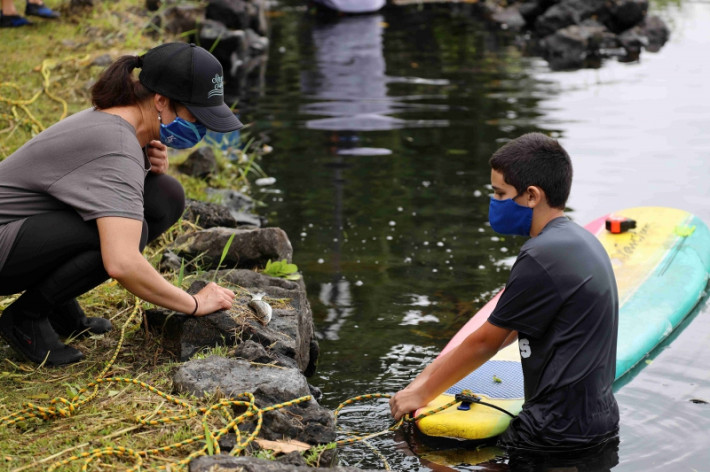After months of distance learning due to the COVID 19 pandemic, KS Hawai‘i sixth grader Alexi Santos was elated to find out that her math class would be taking a huaka‘i (field trip) to the Kumuola Marine Science Center for a day of in-person lessons.
“It was something different, especially during this time,” Santos said of the recent trip. “I thought it was a good way to get out but be safe at the same time and to explore and learn more about our island. I just thought it was going to be an amazing experience.”
Her classmate, Kanoa Honda, felt the same way.
“I was pretty excited for it,” Honda said. “It was fun. It was kind of nice to get outside and socially interact with people instead of seeing them on a screen.”
Prior to the outing, Kumu Layne Arakaki discussed with the Kumuola staff the possibility of using the activities at the outdoor learning center that includes two loko i‘a to help teach his haumāna lessons on measurement.
“We were able to find these activities that were hands-on, very high-interest and really accessible for sixth graders. It would also draw on the skills we were learning in class,” Arakaki said. The Kumuola Marine Science Center is located on ‘Ᾱina Pauahi within the ʻili kūpono of Honohononui in East Hawai‘i.
“Our mission here at Kumuola is the development and growth of ʻāina-conscious leaders through the rehabilitation of our loko iʻa, Waiāhole and Kapalaho,” said Kumuola Director Luke Mead.
He said that the pandemic has also changed things at Kumuola as well.
“Groups are smaller. We are all in masks and physically distanced. We have hand sanitizer everywhere,” Mead said. “However, these changes have not impacted our ability to share our aloha with one another and the ʻāina, to laugh and learn, or to reconnect socially.”
Arakaki said the trip was optional for students and they essentially followed the same safety protocols that they’d normally follow on campus. Both Santos and Honda said the day was the most in-person interaction with other students they’ve had since school started.
But it was also a day of hands-on learning for them. That included learning to throw a fishing net as part of a lesson on calculating the area of the open waters of the fishponds in order to determine the amount of invasive fish species that needed to be removed from the ponds.
For Honda, it turned out to also be a lesson in perseverance – if at first you don’t succeed, try and try again.
“Kumu taught us how to throw net. He kind of showed us the step-by-step and each of us got to try it out on dryland first and it kind of went well,” Honda said. “The first time I threw it, I kind of had it down, but it got tangled so I messed up. I tried a second time. I didn’t get too many fish but it went a lot better.”
Arakaki said, “The students created some strategies and identified the tools they needed and they started measuring. Some of the strategies didn’t work and so they had to revise and come up with other plans when, for example, learning to measure an irregular-shaped pond,” Arakaki said.
For Santos, calculating the area of the water and the pond was also a lesson in working together as a team and using the right tools like surfboards and measuring tape.
“As far as the academic goals go, mainly I wanted them to see that there’s a connection outside of the classroom to math. A lot of kids always say, ‘When am I ever going to use this?,’” Arakaki said. “It’s really exciting when you can pair up an activity outside of the classroom that draws on the skills that they are doing in class.”
Because it was hands-on and in person, the students got to work together and collaborate in different ways than they have been.
“Because our classes have been entirely on Zoom, working together was different. It was also a nice opportunity for students to share ideas verbally and not have to type them – just being able to let students practice in an environment that is face-to-face,” Arakaki said.

A surfboard was one of the tools sixth graders in kumu Layne Arakaki’s math class used to calculate the area of the open water at Kapalaho loko i‘a.

Wearing masks and social distancing, KS Hawai‘i Papa ‘Eono haumāna came together for math class at the outdoor Kumuola Marine Science Education Center.

Practice makes perfect as haumāna learned to “throw net” on land before casting the net in the loko i‘a at the Kumuola Marine Science Education Center.

Haumāna are off to apply their math skills on the open water of Kapalaho loko i‘a.
TAGS
ks hawaii,
kumuola,
covid-19,
hcbe
CATEGORIES
Kaipuolono Article, Regions, West Hawai’i, East Hawai’i, Themes, Culture, Community, Leadership, Hawaii Newsroom, KS Hawaii Home, Newsroom, Campus Programs, Hawaii
Print with photos
Print text only










